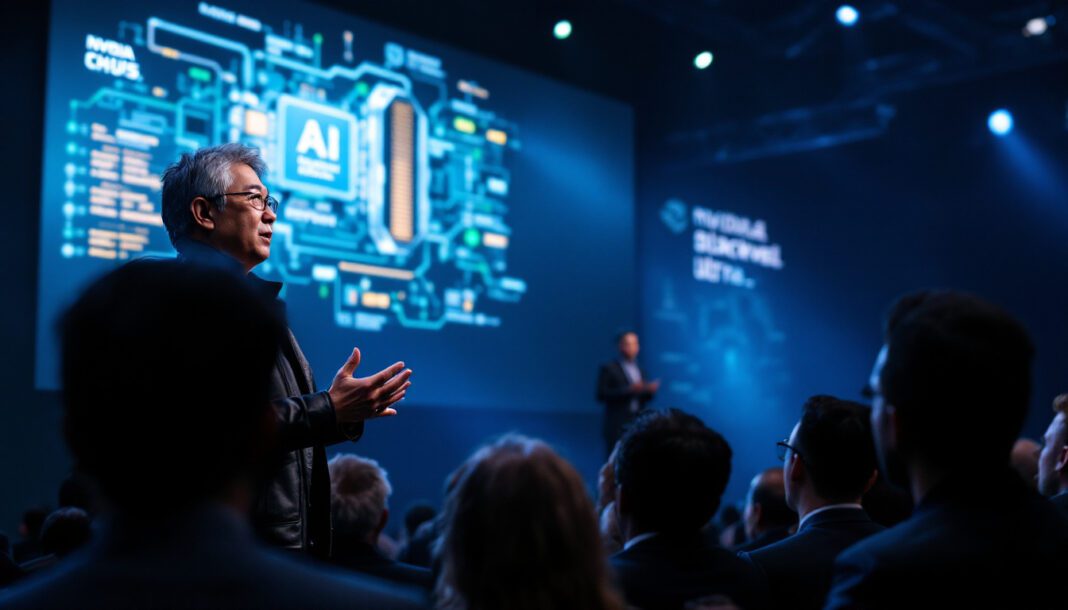Right, let’s talk chips. Not the kind you dunk in vinegar, mind you, but the silicon marvels that are the brains behind, well, pretty much everything interesting these days. And who else but Nvidia, the darlings of the AI world, to drop a couple of whoppers on us? Just when you thought things couldn’t get any faster, they go and announce a significant advancement in their AI chip technology with the next generation Blackwell architecture. Hold onto your hats, folks, because things are about to get seriously speedy in the world of artificial intelligence.
Nvidia Enhances Blackwell Architecture: Performance Upgrade on the Horizon
First up, we’re looking at the enhanced Blackwell architecture. Now, if you’ve been keeping even half an eye on the AI game, you’ll know that Blackwell architecture has already been generating considerable buzz since its announcement. But Nvidia, never ones to rest on their laurels, are pushing its capabilities even further. Think of it as taking a Ferrari and refining the engine for even greater performance. This isn’t just a minor tweak; we’re talking about a significant leap in potential performance for AI workloads. They’re positioning Blackwell as a leading platform for AI acceleration, and it’s easy to see why.
Blackwell Architecture: Expected Release and Capabilities
So, when can you expect to see systems powered by this enhanced architecture? Nvidia is indicating that Blackwell-based products are anticipated to become available starting later in 2024, and from what they’re suggesting, it’s poised to be a major step forward for those tackling the most demanding AI workloads. This includes training massive language models, advancing scientific computing, and handling other computationally intensive tasks. Expect a notable increase in performance compared to current high-end chips when Blackwell products become available. Nvidia hasn’t disclosed all the detailed specifications yet, but the anticipation within the tech industry is already palpable.
Next-Generation AI Focus: Expanding Memory and Interconnectivity
But there’s more to consider in Nvidia’s forward-looking strategy. Beyond the immediate advancements in the Blackwell architecture, Nvidia is also hinting at future directions focusing on groundbreaking developments in memory and interconnectivity for AI. While specific product details are still under wraps, these hints suggest a focus on architectures designed to complement Blackwell and address evolving needs in AI computing. This indicates a broader vision that extends beyond raw power, aiming for more sophisticated and efficient AI solutions.
Future AI Chip Directions: Beyond Current Blackwell
Details on these future chip directions are still emerging, kept deliberately vague by Nvidia at this stage. It appears that Nvidia is planning architectures that will work alongside and enhance the capabilities of Blackwell. Consider Blackwell as providing a foundation of immense processing power, while future architectures may be designed to optimize data handling and memory capabilities. Nvidia is implying that future developments will target areas where memory bandwidth and efficient data movement become increasingly crucial for tackling even more complex AI workloads. Could this pave the way for solving even more intricate AI challenges? Potentially. Timelines for these further advancements remain less defined, suggesting they are part of a longer-term roadmap.
Nvidia’s AI Chip Strategy: Reinforcing Market Leadership
Let’s face it, Nvidia’s continued advancements in AI chip technology are consistent with their established leadership in the field. They’ve been at the forefront of the AI revolution, and these developments further solidify their commitment to maintaining that position. What stands out is the scale of their ambition. Simultaneously advancing current architectures while hinting at significant future innovations demonstrates a comprehensive strategy. It’s clear they’re not just making incremental improvements; they are actively shaping the trajectory of AI computing. And importantly, these insights were shared at Nvidia GTC, their key annual event that serves as a bellwether for the AI industry. For anyone tracking the future of AI, GTC is a crucial event to follow.
Blackwell Architecture and Future Directions: Balancing Power and Efficiency
The key takeaway seems to be a dual approach: continuously enhancing the Blackwell architecture for raw computational power while also strategically planning future architectures to address bottlenecks in memory and data handling. It’s not about choosing one over the other, but rather creating a comprehensive ecosystem of AI computing solutions. Blackwell is clearly intended as the powerhouse for computationally intensive tasks. Think large-scale model training, complex simulations, and applications demanding massive processing capabilities. Concurrently, Nvidia is signaling an intent to innovate in areas that optimize data flow and memory access, which will be vital for handling increasingly large datasets, real-time AI inference, and potentially pushing the boundaries of edge computing. It’s a strategy focused on both speed and smart, efficient performance across diverse AI applications.
The Broader Impact: Implications for the AI Landscape
What do these advancements in chip technology mean for the broader AI landscape? In the near future, organizations and researchers engaged in advanced AI development will gain access to increasingly powerful tools. Faster processing, more complex models, and the ability to tackle previously insurmountable problems become more attainable. This could accelerate progress across numerous fields, from accelerating drug discovery processes to creating more detailed climate models. For everyday users, the immediate impact might be less direct, but the underlying advancements will gradually enhance the AI-driven applications we interact with daily – from improved virtual assistants on our devices to more intelligent algorithms shaping our online experiences.
The Ongoing Need for Advanced AI Computing
One might question the necessity for such powerful chips. Is AI technology advancing too rapidly? It’s a valid point to consider. However, the demand for AI capabilities is showing no signs of slowing down. As we challenge AI to solve increasingly complex and nuanced problems, the computational demands will inevitably grow. Consider the potential of truly personalized medicine, AI-driven scientific breakthroughs, or even the long-term pursuit of artificial general intelligence. These ambitious goals will require levels of computing power that currently seem almost unimaginable. Nvidia, by continually pushing the boundaries of AI chip technology, is anticipating this escalating demand and positioning itself to provide the necessary computational resources for future AI innovations.
My Thoughts: Nvidia’s Vision for AI’s Trajectory
Nvidia is consistently demonstrating its commitment to driving the future of AI computing through ongoing advancements in chip technology. The enhancements to the Blackwell architecture and hints at future memory and interconnectivity focused designs represent a significant investment in the evolution of AI. The precise details of future architectures are still emerging. But one thing is evident: Nvidia is not just creating chips; they are constructing the foundational infrastructure for an increasingly AI-driven world. And based on these developments, that future is approaching rapidly. Prepare for a period of significant advancement and innovation in the field of artificial intelligence.



